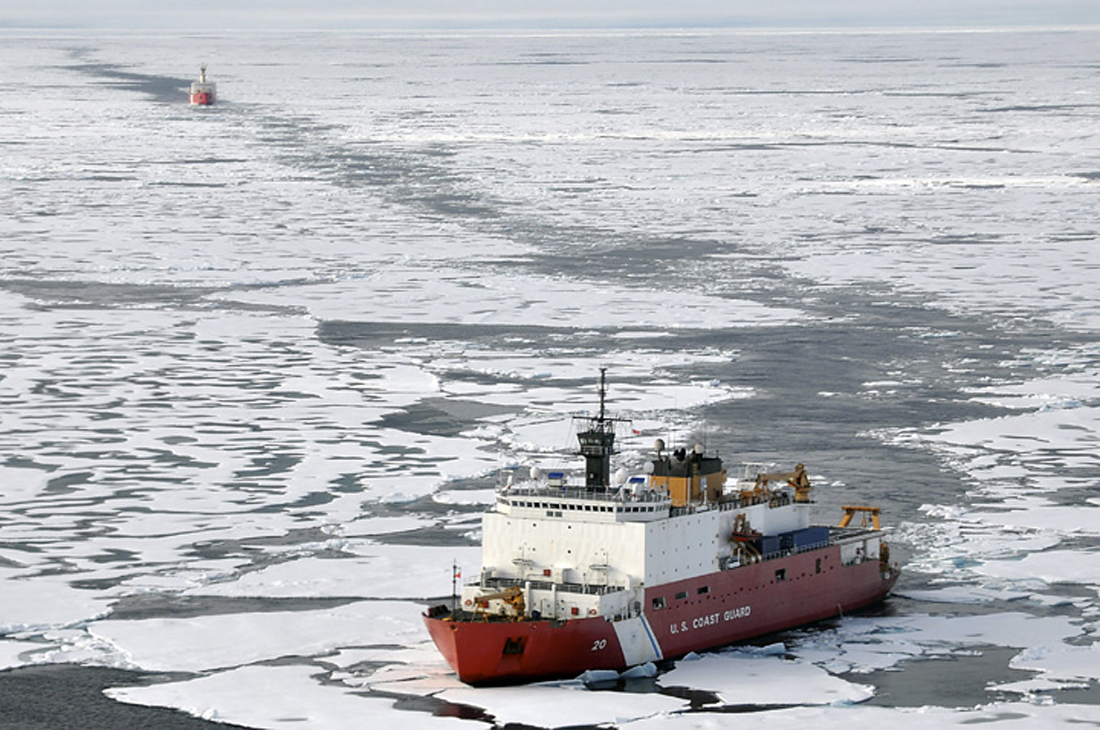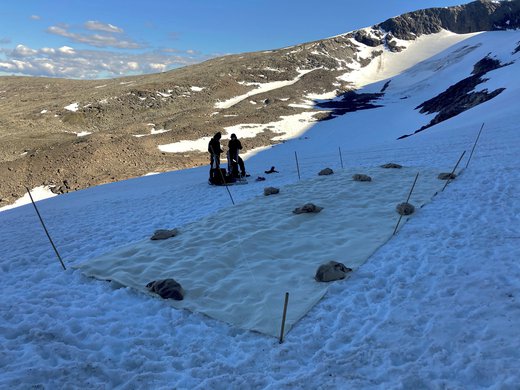From late 2015 to early 2017, there was a flurry of Arctic policy making during the brief period when former US President Barack Obama’s time in office overlapped with that of Canadian Prime Minister Justin Trudeau. The like-minded leaders seized the opportunity to advance a North American agenda for action on climate change, energy development and Arctic leadership, including a bold moratorium on new offshore oil and gas drilling.
This shared agenda was quickly abandoned after the election of Donald Trump. Canada lost its American partner and suddenly had to defend its other core interests from an erratic president, notably the forced renegotiation of the North American free trade area. Overshadowed by scandals and outrage in Washington, the Arctic receded from view. The Trudeau government eventually released a much-anticipated Arctic and Northern Policy Framework (ANPF) the day before calling the 2019 federal election, but the new policy was disappointing.
Although based on consultation with Northern, Indigenous and other stakeholders, the ANPF failed to identify clear priorities, set a national Arctic agenda or commit new resources to addressing Arctic problems. As two colleagues wrote at the time, the ANPF lays out laudable goals, but “the remainder of the document is light on concrete policy action. There are no budgets and no timelines. A clear federal plan is hard to discern.” For the last five years, the Arctic has remained mostly out of the headlines, and out of mind.
Today, that has changed.
Amid the ongoing challenges of the COVID-19 pandemic, dire new assessments of the pace and scale of global climate change, and a volatile new chapter in international relations, the Arctic is again at the fore of global politics. In the wake of Russian’s renewed, full-scale invasion of Ukraine, the seven other Arctic states – Canada, Denmark, Finland, Iceland, Norway, Sweden, and the United States – have suspended their participation in the Arctic Council. Russia’s actions risk reversing 25 years of pan-Arctic cooperation and furthering the region's fragmentation into distinct and competing sub-regions.
In this context, Canada must react, and should redouble its engagement on Arctic issues, while cementing the unity among its other circumpolar neighbours. Doing so offers opportunities to address longstanding diplomatic irritants among the Western Arctic states, buttress the international response towards Russian aggression, re-establish Canadian leadership and enhance its national interests in the circumpolar region.
Numerous challenging issues in the Arctic defy fast or easy solutions. However, Canada has three international boundary disputes that should be resolved through diplomatic means: over Hans Island, the Beaufort Sea and the Northwest Passage (NWP). Moreover, such diplomacy would primarily occur between Canada and its closest allies, not its rivals or potential adversaries. Reaffirming international boundaries will help resolve some Arctic challenges, but others require thinking differently about borders in order to enhance Indigenous mobility across colonially imposed national borders between Canada, the United States and Greenland. Resolving existing boundary disputes while exploring possibilities to enhance mobility rights for Indigenous residents of the Arctic in accordance with recent Supreme Court of Canada jurisprudence would advance the ANPF’s goals of strengthening the rules-based regional order by clarifying Canada’s Arctic borders and promoting reconciliation and self-determination for Indigenous peoples.
The Arctic has few boundary disputes, and contrary to oft-cited concerns about territorial aggression from Russia, Canada’s most important diplomatic disagreements are actually with its close friends and allies.
Resolving Canada’s Arctic Boundary Disputes
The Arctic has few boundary disputes, and contrary to oft-cited concerns about territorial aggression from Russia, Canada’s most important diplomatic disagreements are actually with its close friends and allies. In particular, Canada has unresolved Arctic boundary disputes with Denmark over Hans Island, with the United States over the maritime boundary in the Beaufort Sea, and regarding the legally uncertain claim that the NWP comprises Canada’s internal waters. Each of these must be addressed to facilitate continued good relations among the Western Arctic allies and provide a common front against potential adversaries.
Hans Island should be the easiest to resolve. Although the dispute periodically reappears in the media, there is no underlying national interest at stake; Canada and Denmark’s rival claims to the uninhabited, resourceless rock somewhat larger than a football field are a long-running joke within their militaries and foreign ministries, and the idea that either country would use force to assert their claims is absurd. In 2018, the two countries announced a joint task force to examine the dispute and issue recommendations for its resolution, but this has produced no apparent progress. As University of British Columbia scholar Michael Byers has noted, there are different possibilities for resolving the issue, including dividing or managing Hans Island jointly. Given the island’s lack of people, resources or strategic importance, the specific resolution matters little. Rather, settling the Hans Island dispute would benefit Canada by removing a source of periodic diplomatic irritation with a like-minded Arctic neighbour, allowing for strengthened relations between middle powers and NATO allies in the context of increased tensions in the Arctic and in Europe.
Canada’s boundary dispute with the United States in the Beaufort Sea region between Yukon and Alaska will be more difficult to resolve, both because of the stakes and the negotiating partner involved. The dispute is an inherited one: Canada and the United States disagree over the legal interpretation of an 1825 treaty, which neither country actually signed but was settled between the United Kingdom and the Russian Empire. The details of the dispute refer to the appropriate angle of the international boundary when it leaves the land and divides the waters of the Beaufort Sea, but the two countries’ positions are counterintuitive. Although the desired extraction of offshore fossil fuels has been cited as the reason for the ongoing disagreement, under the proposed Canadian interpretation, the United States would actually gain more marine territory, and vice versa, making the dispute a matter of principle rather than material gain.
What matters more than economic rents for fossil fuels that are unlikely to be developed is a political question: Can Canada and the United States cooperatively manage their Arctic relations during a challenging time in their bilateral relationship? The question isn’t abstract; in 2010, Norway and Russia negotiated a resolution to a similar maritime boundary dispute involving far larger fossil fuel deposits in the Barents Sea. That agreement ended a 40-year dispute between former Cold War adversaries with a long, complicated and often-hostile relationship. Given that, is it unrealistic to expect that close friends, allies and partners such as Canada and the United States — who often boast of the world’s closest bilateral relationship — could resolve the Beaufort boundary dispute on a similar basis? Canada and the United States should follow the example of Norway and Russia by drawing a line down the middle of the disputed area and call it a day.
Finally, Canada must develop a more robust framework for international use of the NWP. Canada asserts that, according to the Law of the Sea, the NWP comprises internal waters over which Canada exercises complete authority over marine transit and other nautical activities. The United States and other countries insist the NWP is an international strait through which all vessels have a right to innocent passage. In the late 1980s, after the US Coast Guard icebreaker Polar Sea traversed the NWP without Canadian authorization, Canada and the United States signed an agreement whereby the United States would not enter the NWP without Canadian permission, but Canada guaranteed that such permission would always be granted. The agreement states that it does not prejudice each state’s differing claim over the legal status of the NWP but establishes a mechanism to manage actual use of the passage. In 2019, however, the Trump administration reversed 30 years of precedent by characterizing Canada’s legal claims to the NWP as internal waters as “illegitimate.” Although it came amid an increasingly hectic period in international politics, this event reminded officials of the legal and political uncertainty surrounding the NWP and the depth of Canada’s reliance on American goodwill and cooperation.
The underlying legal dispute surrounding the NWP is complex, and unlikely to be fully resolved. A legal opinion will likely be required someday from the International Court of Justice, but most necessary now is to reaffirm the 1988 Canada-US agreement as the framework for actual entry and navigation of the NWP. To that end, Canada should seek to renew the nearly 35-year-old agreement with the United States. This would not only reaffirm the status quo that existed before Trump, but also provide an opportunity to update the agreement to include reference to the effects of climate change; increased international interest in the NWP, with accompanying considerations for North American security and defence; and the terms of the 2016 Canada-US Arctic leaders’ agreement. Such a bilateral reaffirmation of the existing model for the NWP would help settle the Canadian jitters inspired by four years of Donald Trump and concerns about continual American disregard for Canada’s interests.
However, renewing the NWP agreement could also offer an opportunity for Canada to be bold, and exercise leadership in the circumpolar region. Building on the terms of the bilateral Canada-US agreement, Canada could seek to negotiate a multilateral framework for use of the NWP. Such a multilateral agreement would afford other countries the opportunity to sign on to the existing framework: Canadian permission to traverse the NWP in exchange for guarantees that such permission will always be sought. While such an agreement could be negotiated in different fora and participation extended to countries on various bases, the ideal starting point might be the site of much of Canada’s prior Arctic leadership: the Arctic Council. Since 2011, the eight council members have negotiated three international agreements on different high-stakes Arctic policy issues. A multilateral agreement on the use of the NWP would be a worthy addition to that list, and provide Canada with an opportunity for an enhanced maritime regulatory regime that facilitated peaceful and orderly use of the NWP, maintained its legal position and ultimately strengthened that position by establishing precedent for Canadian authorization of all transits through Canada’s Arctic waters.
Beyond addressing existing boundary disputes, however, Canada should also think more creatively about its borders, including specific ways to make them more porous to Arctic Indigenous peoples.
Cross-Border Indigenous Mobility in the Arctic
Beyond addressing existing boundary disputes, however, Canada should also think more creatively about its borders, including specific ways to make them more porous to Arctic Indigenous peoples. Indigenous peoples have long noted that their presence precedes the designation of colonial boundaries, and indicate those boundaries have often divided peoples among themselves and produced significant hardship for affected communities and nations. For instance, the 1794 Jay Treaty between the British Crown and the United States granted Indigenous peoples the reciprocal right to freely cross the new border, but was never ratified or honoured by Canada. Some Indigenous communities still hold ceremonies and engage in other activities to assert their treaty right to free movement across the border. For instance, the Gwich’in Tribal Council advocates for its citizens’ right to move freely through its territory across what it deems an artificial border. In its submission to the federal government’s consultations for the ANPF, the council emphasized the “the implementation of the Jay Treaty to facilitate mobility amongst Gwich’in and Gwich’in communities” over all other priorities. As part of its commitment to reconciliation and respect for Indigenous self-determination, Canada could take steps to facilitate cross-border mobility rights for Indigenous peoples residing in the United States who share social, cultural, ecological and economic ties across the border.
On this issue, Canada should act proactively, rather than wait until it has little choice. The Supreme Court’s ruling in the recent case of R. v. Desautel extended constitutional rights to non-citizen Indigenous people with historical claims to using lands that are today under Canadian sovereignty. This case applies directly to southern British Columbia, but it highlights the constitutional protection of Indigenous cross-border rights. At least two more title claims from non-resident groups have been filed since Desautel was decided in 2019, meaning the courts may soon weigh in again on Indigenous title claims for non-Canadian residents. Rather than wait for policy to be set from the bench, the Government of Canada should seize the initiative and legislate cross-border mobility rights for neighbouring Indigenous nations with claims to traditional territory in Canada.
But Canada should go further and explore a free travel zone between the Inuit regions in Northern Canada and those in the United States and Greenland. Such an initiative would anticipate the inevitable legal challenge from Yupik (Alaska Inuit) and Kalaallit (Greenlandic Inuit) that the transnational homeland of Inuit Nunangat traverses modern state boundaries in the North American Arctic. Since the Yupik and Kalaallit ancestors of modern Inuit peoples would have travelled unimpeded by borders or boundaries across land, ice and waters at the time of the assertion of British sovereignty over the High Arctic, the precedent established in Desautel likely implies constitutional rights to mobility and use of Canadian Arctic lands and waters by non-Canadian Inuit. The legal framework for this free travel zone would require creating a specific Inuit travel visa or passport, which, if recognized in Canadian law, would mean Inuit would not encounter the same difficulties as other cross-border Indigenous peoples, such as the Haudenosaunee Confederacy in Ontario, Quebec and upstate New York (who may gain new rights themselves due to the Desautel decision). Such an Inuit travel zone could be developed between the Government of Canada and key stakeholders, including territorial governments; Inuit land claim corporations; Inuit Tapiriit Kanatami, the national Inuit organization in Canada; the governments of Greenland, Alaska and the United States; and the transnational Inuit Circumpolar Council, which represents Inuit at the Arctic Council and across the four modern states that encompass their homeland.
Inuit organizations have called for such a travel zone since at least the 1980s, and some observers have proposed similar ideas for an “Inuit Union” that would facilitate travel in order to support extended family and kinship ties; protect cultural traditions; improve access to education, health and other public services; and facilitate unrestricted employment and economic opportunities in Inuit Nunangat. A report of the transnational Pikialasorsuaq Commission released in 2017 proposed a similar model for the future governance of the North Water Polynya located between Northern Canada and Greenland. The commission called for an Inuit-led partnership with the collaboration of Canada and Greenland to manage the ecological region between the southern coast of Ellesmere Island and the west coast of Greenland, and to facilitate free movement between the Canadian and Greenlandic coasts. This preliminary work on improving connectivity for Inuit between Canada and Greenland provides a basis for developing a more robust framework for Indigenous mobility across both Canada’s eastern and western Arctic borders. Doing so would not only strengthen reconciliation efforts between Inuit and the Crown, but would also represent an effort to develop policies in the Canadian Arctic that address emerging issues such as the Desautel decision proactively, rather than after years of expensive and harmful litigation. Coming with Her Excellency Mary Simon in office as Canada’s first Indigenous and Inuk Governor General, and on the heels of widespread criticism of the federal government’s penchant for excessive litigation against Indigenous people, the symbolic and practical significance of a proactive and collaborative approach toward Indigenous policy in the Arctic should not be understated.
With Joe Biden in the White House and renewed attention to the challenges facing the North Atlantic allies in multiple theatres, the time is right for Canada to secure its national interests.
The Time to Focus on the Arctic Is Now
Canada has had many Arctic policies over the decades, but only so much ever changes. With eight different priorities and no new funding, the Trudeau government’s 2019 ANPF looks and feels similar to the Harper government’s 2009 Northern strategy. Ultimately, the ANPF felt to many like a rush job that avoided hard decisions, reflected a lack of consensus among stakeholders and suggested a lack of interest by the government in prioritizing Arctic policy. In the more than two years since it was released, little has happened, but everything has changed, and Arctic issues have been further displaced by the massive disruption of the COVID-19 pandemic, political instability in the United States, and further deterioration in great power relations from Europe to Asia.
Canada should not wait for the world to return its focus to the Arctic. With Joe Biden in the White House and renewed attention to the challenges facing the North Atlantic allies in multiple theatres, the time is right for Canada to secure its national interests, promote bilateral and multilateral Arctic cooperation, and renew its regional leadership. To form a more cohesive and united front against adversaries elsewhere, Canada and its allies should work to finally resolve the outstanding diplomatic issues that still linger in the North American Arctic. The disputes around Hans Island and the Beaufort Sea are enduring, but should not be insurmountable. Successfully resolving them would demonstrate that Canada, Denmark/Greenland and the United States are at least as able to negotiate a resolution over their minor territorial disputes as their fellow NATO member Norway was at resolving its maritime boundary with Russia itself. Failing to do so, on the other hand, will only feed continuing doubts about the depth and durability of the strategic and political ties that bind the two sides of the Atlantic.
Likewise, reaffirming the principles of the 1988 Canada-US agreement on the NWP would shore up the shaky American commitment to the status quo and provide an opportunity for Canada to broaden the international support for that status quo. A multilateral agreement involving all eight Arctic states — or, given the circumstances, perhaps all but Russia — would strengthen Canada’s position vis-à-vis the passage as internal waters by reaffirming the existing norm of foreign vessels requesting permission to enter Canadian waters. It would build on the previous diplomatic successes of the Arctic Council, and help maintain the circumpolar region as a space where geopolitics are effectively managed by international law and institutions.
Finally, Canada should anticipate the kinds of legislative and policy changes that the constitutional interpretations of its judiciary have or will impose on it, and act first. While some of Canada’s Arctic borders can be usefully affirmed, others may be usefully rendered more permeable to the timeless patterns of movement practised by Indigenous peoples. Whether in the Yukon-Alaska border region, or the waters and ice that separate the Inuit homelands in Canada and Greenland, there are practical, ethical and now legal reasons for the federal government to undertake negotiations to facilitate cross-border Indigenous mobility. Ultimately, the outcome of such negotiations will not lie solely in Canada’s hands; however, committing its diplomatic resources toward achieving goals that specifically benefit Indigenous peoples in the North would represent a commitment to reconciliation even when the work is hard, the outcome uncertain and the potential changes that Canada would have to adapt to are considerable.
It would be a demonstration of reconciliation in action — not as an empty buzzword, but as a vital relationship between Indigenous and Canadian nations that inhabit the same state, and that can choose to build a more just society one border policy at a time.



